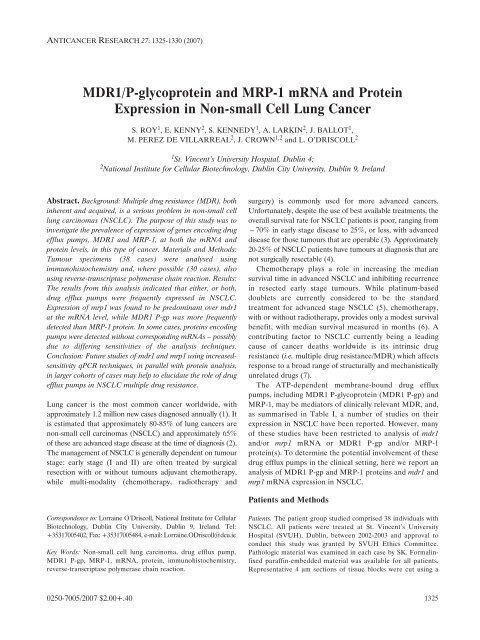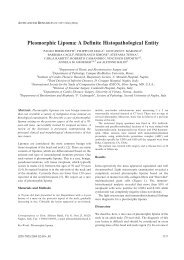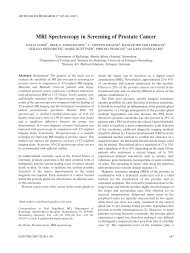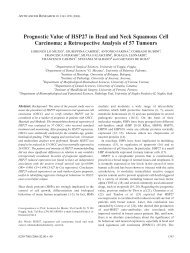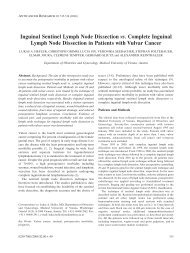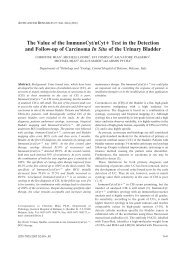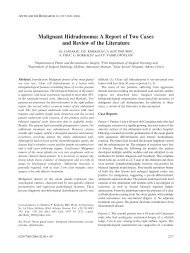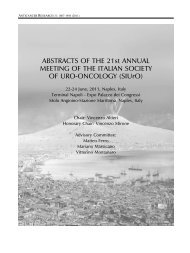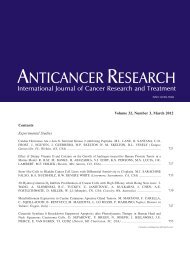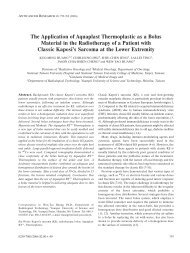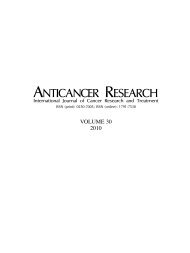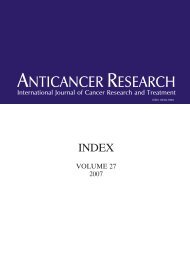MDR1/P-glycoprotein and MRP-1 mRNA and Protein Expression in ...
MDR1/P-glycoprotein and MRP-1 mRNA and Protein Expression in ...
MDR1/P-glycoprotein and MRP-1 mRNA and Protein Expression in ...
Create successful ePaper yourself
Turn your PDF publications into a flip-book with our unique Google optimized e-Paper software.
ANTICANCER RESEARCH 27: 1325-1330 (2007)<br />
<strong>MDR1</strong>/P-<strong>glycoprote<strong>in</strong></strong> <strong>and</strong> <strong>MRP</strong>-1 <strong>mRNA</strong> <strong>and</strong> <strong>Prote<strong>in</strong></strong><br />
<strong>Expression</strong> <strong>in</strong> Non-small Cell Lung Cancer<br />
Abstract. Background: Multiple drug resistance (MDR), both<br />
<strong>in</strong>herent <strong>and</strong> acquired, is a serious problem <strong>in</strong> non-small cell<br />
lung carc<strong>in</strong>omas (NSCLC). The purpose of this study was to<br />
<strong>in</strong>vestigate the prevalence of expression of genes encod<strong>in</strong>g drug<br />
efflux pumps, <strong>MDR1</strong> <strong>and</strong> <strong>MRP</strong>-1, at both the <strong>mRNA</strong> <strong>and</strong><br />
prote<strong>in</strong> levels, <strong>in</strong> this type of cancer. Materials <strong>and</strong> Methods:<br />
Tumour specimens (38 cases) were analysed us<strong>in</strong>g<br />
immunohistochemistry <strong>and</strong>, where possible (30 cases), also<br />
us<strong>in</strong>g reverse-transcriptase polymerase cha<strong>in</strong> reaction. Results:<br />
The results from this analysis <strong>in</strong>dicated that either, or both,<br />
drug efflux pumps were frequently expressed <strong>in</strong> NSCLC.<br />
<strong>Expression</strong> of mrp1 was found to be predom<strong>in</strong>ant over mdr1<br />
at the <strong>mRNA</strong> level, while <strong>MDR1</strong> P-gp was more frequently<br />
detected than <strong>MRP</strong>-1 prote<strong>in</strong>. In some cases, prote<strong>in</strong>s encod<strong>in</strong>g<br />
pumps were detected without correspond<strong>in</strong>g <strong>mRNA</strong>s – possibly<br />
due to differ<strong>in</strong>g sensitivities of the analysis techniques.<br />
Conclusion: Future studies of mdr1 <strong>and</strong> mrp1 us<strong>in</strong>g <strong>in</strong>creasedsensitivity<br />
qPCR techniques, <strong>in</strong> parallel with prote<strong>in</strong> analysis,<br />
<strong>in</strong> larger cohorts of cases may help to elucidate the role of drug<br />
efflux pumps <strong>in</strong> NSCLC multiple drug resistance.<br />
Lung cancer is the most common cancer worldwide, with<br />
approximately 1.2 million new cases diagnosed annually (1). It<br />
is estimated that approximately 80-85% of lung cancers are<br />
non-small cell carc<strong>in</strong>omas (NSCLC) <strong>and</strong> approximately 65%<br />
of these are advanced stage disease at the time of diagnosis (2).<br />
The management of NSCLC is generally dependent on tumour<br />
stage: early stage (I <strong>and</strong> II) are often treated by surgical<br />
resection with or without tumours adjuvant chemotherapy,<br />
while multi-modality (chemotherapy, radiotherapy <strong>and</strong><br />
Correspondence to: Lorra<strong>in</strong>e O'Driscoll, National Institute for Cellular<br />
Biotechnology, Dubl<strong>in</strong> City University, Dubl<strong>in</strong> 9, Irel<strong>and</strong>. Tel:<br />
+35317005402, Fax: +35317005484, e-mail: Lorra<strong>in</strong>e.ODriscoll@dcu.ie<br />
Key Words: Non-small cell lung carc<strong>in</strong>oma, drug efflux pump,<br />
<strong>MDR1</strong> P-gp, <strong>MRP</strong>-1, <strong>mRNA</strong>, prote<strong>in</strong>, immunohistochemistry,<br />
reverse-transcriptase polymerase cha<strong>in</strong> reaction.<br />
0250-7005/2007 $2.00+.40<br />
S. ROY 1 , E. KENNY 2 , S. KENNEDY 1 , A. LARKIN 2 , J. BALLOT 1 ,<br />
M. PEREZ DE VILLARREAL 2 , J. CROWN 1,2 <strong>and</strong> L. O’DRISCOLL 2<br />
1 St. V<strong>in</strong>cent’s University Hospital, Dubl<strong>in</strong> 4;<br />
2 National Institute for Cellular Biotechnology, Dubl<strong>in</strong> City University, Dubl<strong>in</strong> 9, Irel<strong>and</strong><br />
surgery) is commonly used for more advanced cancers.<br />
Unfortunately, despite the use of best available treatments, the<br />
overall survival rate for NSCLC patients is poor, rang<strong>in</strong>g from<br />
~ 70% <strong>in</strong> early stage disease to 25%, or less, with advanced<br />
disease for those tumours that are operable (3). Approximately<br />
20-25% of NSCLC patients have tumours at diagnosis that are<br />
not surgically resectable (4).<br />
Chemotherapy plays a role <strong>in</strong> <strong>in</strong>creas<strong>in</strong>g the median<br />
survival time <strong>in</strong> advanced NSCLC <strong>and</strong> <strong>in</strong>hibit<strong>in</strong>g recurrence<br />
<strong>in</strong> resected early stage tumours. While plat<strong>in</strong>um-based<br />
doublets are currently considered to be the st<strong>and</strong>ard<br />
treatment for advanced stage NSCLC (5), chemotherapy,<br />
with or without radiotherapy, provides only a modest survival<br />
benefit, with median survival measured <strong>in</strong> months (6). A<br />
contribut<strong>in</strong>g factor to NSCLC currently be<strong>in</strong>g a lead<strong>in</strong>g<br />
cause of cancer deaths worldwide is its <strong>in</strong>tr<strong>in</strong>sic drug<br />
resistance (i.e. multiple drug resistance/MDR) which affects<br />
response to a broad range of structurally <strong>and</strong> mechanistically<br />
unrelated drugs (7).<br />
The ATP-dependent membrane-bound drug efflux<br />
pumps, <strong>in</strong>clud<strong>in</strong>g <strong>MDR1</strong> P-<strong>glycoprote<strong>in</strong></strong> (<strong>MDR1</strong> P-gp) <strong>and</strong><br />
<strong>MRP</strong>-1, may be mediators of cl<strong>in</strong>ically relevant MDR, <strong>and</strong>,<br />
as summarised <strong>in</strong> Table I, a number of studies on their<br />
expression <strong>in</strong> NSCLC have been reported. However, many<br />
of these studies have been restricted to analysis of mdr1<br />
<strong>and</strong>/or mrp1 <strong>mRNA</strong> or <strong>MDR1</strong> P-gp <strong>and</strong>/or <strong>MRP</strong>-1<br />
prote<strong>in</strong>(s). To determ<strong>in</strong>e the potential <strong>in</strong>volvement of these<br />
drug efflux pumps <strong>in</strong> the cl<strong>in</strong>ical sett<strong>in</strong>g, here we report an<br />
analysis of <strong>MDR1</strong> P-gp <strong>and</strong> <strong>MRP</strong>-1 prote<strong>in</strong>s <strong>and</strong> mdr1 <strong>and</strong><br />
mrp1 <strong>mRNA</strong> expression <strong>in</strong> NSCLC.<br />
Patients <strong>and</strong> Methods<br />
Patients. The patient group studied comprised 38 <strong>in</strong>dividuals with<br />
NSCLC. All patients were treated at St. V<strong>in</strong>cent’s University<br />
Hospital (SVUH), Dubl<strong>in</strong>, between 2002-2003 <strong>and</strong> approval to<br />
conduct this study was granted by SVUH Ethics Committee.<br />
Pathologic material was exam<strong>in</strong>ed <strong>in</strong> each case by SK. Formal<strong>in</strong>fixed<br />
paraff<strong>in</strong>-embedded material was available for all patients.<br />
Representative 4 Ìm sections of tissue blocks were cut us<strong>in</strong>g a<br />
1325
microtome, mounted onto poly-l-lys<strong>in</strong>e coated slides <strong>and</strong> dried<br />
overnight at 37ÆC. Slides were stored at room temperature until<br />
required. Snap-frozen tissue from 30 of these tumours was also<br />
available for <strong>mRNA</strong> analysis.<br />
Immunohistochemical analysis of MDR-1/Pgp <strong>and</strong> <strong>MRP</strong>-1 prote<strong>in</strong><br />
expression. All immunohistochemical studies on formal<strong>in</strong>-fixed<br />
paraff<strong>in</strong> wax-embedded tissue sections were performed follow<strong>in</strong>g<br />
the method of Hsu et al. (17), us<strong>in</strong>g an avid<strong>in</strong>-biot<strong>in</strong> horseradish<br />
peroxidase (HRP) conjugated kit (avid<strong>in</strong>-biot<strong>in</strong> complex; ABC) plus<br />
an appropriate secondary antibody. In brief, sections were dewaxed<br />
<strong>in</strong> xylene (2x5 m<strong>in</strong>), rehydrated <strong>in</strong> grad<strong>in</strong>g alcohols 100%, 90% <strong>and</strong><br />
70% (2x3 m<strong>in</strong>), <strong>and</strong> placed <strong>in</strong> tris-buffered sal<strong>in</strong>e (TBS/0.1%<br />
Tween-20). Endogenous peroxidase activity was quenched by<br />
plac<strong>in</strong>g tissue sections <strong>in</strong> 3% (v/v) H 2 O 2 /distilled water for 5-7 m<strong>in</strong><br />
at room temperature. All slides were blocked for non-specific<br />
sta<strong>in</strong><strong>in</strong>g with 20% normal rabbit serum (Dako, High Wycombe, UK:<br />
X-902)/TBS for 20 m<strong>in</strong> at room temperature. Primary antibodies<br />
were applied to each sample optimally diluted <strong>in</strong> TBS/0.1% Tween-<br />
20 (anti-MDR-1, clone 6/1C (National Institute for Cellular<br />
ANTICANCER RESEARCH 27: 1325-1330 (2007)<br />
Table I. Summary of previously reported MDR-1 <strong>and</strong> <strong>MRP</strong>-1 studies <strong>in</strong> human NSCLC specimens.<br />
No. of NSCLC MDR-1 <strong>MRP</strong>-1 Results Reference<br />
specimens (method) (method)<br />
6 (+ 7 normal) mdr1 <strong>mRNA</strong> Not studied low levels mdr1 <strong>mRNA</strong> <strong>in</strong> NSCLC <strong>and</strong> normal lung tissue (8)<br />
(Slot Blot)<br />
107 (+ 20 normal) mdr1 <strong>mRNA</strong> Not studied 57% (61/107) tumours, 90% (18/20) normal tissue positive; (9)<br />
(RT-PCR) 1 tumour only > level than normal<br />
104 mdr1 <strong>mRNA</strong> mrp1 <strong>mRNA</strong> mrp1: 31.7% (33/104) with high level expression; (10)<br />
(RT-PCR) (Northern blot) some · worse prognosis<br />
29 <strong>MDR1</strong> P-gp Not studied 45% <strong>MDR1</strong> P-gp-positive, with no with disease stage (11)<br />
(IHC)<br />
11 mdr1 <strong>mRNA</strong> mrp1 <strong>mRNA</strong> most co-express mdr1 <strong>and</strong> mrp1 <strong>mRNA</strong>; (12)<br />
(RT-PCR) (RT-PCR) generally low level mdr1 <strong>mRNA</strong><br />
84 mdr1 Not studied 15% mdr1 positive; generally low level; no · drug (13)<br />
(Northern Blot) resistance <strong>and</strong> tumour progression<br />
27 <strong>MDR1</strong> P-gp <strong>MRP</strong>-1 <strong>MDR1</strong> P-gp prote<strong>in</strong>: 11% (3/27) had >5% positive cells; (14)<br />
(IHC) (IHC) <strong>MRP</strong>-1 prote<strong>in</strong>: 18.5% (5/27) had >5% positive cells<br />
50 <strong>MDR1</strong> P-gp Not studied 100% (28/28) of "good responders" were <strong>MDR1</strong> P-gp positive; (15)<br />
(pre-paclitaxel) (IHC) 68% (15/22) "poor responders" were <strong>MDR1</strong> P-gp positive<br />
72 <strong>MDR1</strong> P-gp <strong>MRP</strong>-1 35% (25/72) <strong>MDR1</strong> P-gp-positive; (16)<br />
(IHC) (IHC) 78% (56/72) <strong>MRP</strong>-1-positive<br />
No significant · with chemo-response or survival<br />
116 <strong>MDR1</strong> P-gp <strong>MRP</strong>-1 <strong>MDR1</strong> P-gp expression levels similar to surround<strong>in</strong>g normal tissue; (7)<br />
(IHC) (IHC) <strong>MRP</strong>-1 levels significantly <strong>in</strong>creased <strong>in</strong> NSCLC. High levels of<br />
4 4 cases: mdr1 4 cases: mrp1 expression with longer overall survival.<br />
(RT-PCR) (RT-PCR)<br />
IHC: immunohistochemistry; ·: associated with; RT-PCR: reverse transcriptase-polymerase cha<strong>in</strong> reaction.<br />
1326<br />
Biotechnology)) (18): ascites diluted 1:40; anti-<strong>MRP</strong>-1 monoclonal<br />
antibody (diluted 1:15; ALX-801-007-C125: Alexis, Nott<strong>in</strong>gham,<br />
UK). Primary antibodies were <strong>in</strong>cubated overnight at 4ÆC.<br />
Specimens were then washed (3x5 m<strong>in</strong>) with TBS/0.1% Tween-20,<br />
followed by a 30 m<strong>in</strong> <strong>in</strong>cubation with biot<strong>in</strong>ylated secondary<br />
antibody (rabbit anti-mouse IgG; 1/300 dilution <strong>in</strong> TBS/0.1%<br />
Tween-20) (Dako, E345)) or rabbit anti-rat (1/500 dilution <strong>in</strong><br />
TBS/0.1% Tween-20). F<strong>in</strong>ally, follow<strong>in</strong>g another 3x5 m<strong>in</strong> wash step,<br />
Vectasta<strong>in</strong> Elite ABC reagent (HRP-conjugated; Vector<br />
Laboratories, UK) was applied for 25 m<strong>in</strong> at room temperature.<br />
The peroxidase substrate, 3’,3-dam<strong>in</strong>obenzid<strong>in</strong>e tetrahydrochloride<br />
(DAB) conta<strong>in</strong><strong>in</strong>g 0.02% H 2 O 2 (Vector Laboratories) was added<br />
for 10 m<strong>in</strong> at room temperature. Tissue sections were then lightly<br />
counter sta<strong>in</strong>ed with Crazzi’s haematoxyl<strong>in</strong> (Vector Laboratories).<br />
Follow<strong>in</strong>g this, slides were dehydrated <strong>in</strong> grad<strong>in</strong>g alcohols: 70%,<br />
90% <strong>and</strong> 100% (2x3 m<strong>in</strong>). Specimens were then cleared <strong>in</strong> xylene<br />
<strong>and</strong> mounted <strong>in</strong> DPX (BDH, UK). Negative control specimens, <strong>in</strong><br />
which primary antibodies were replaced by 1x TBS/0.1% Tween-20,<br />
<strong>and</strong> positive controls (normal kidney <strong>and</strong> lung tissue) us<strong>in</strong>g the<br />
same experimental conditions, were <strong>in</strong>cluded <strong>in</strong> all experiments.
Table II. Primers used to amplify cDNA formed by reverse transcription of<br />
<strong>mRNA</strong> templates.<br />
cDNA Primer sequences Anneal<strong>in</strong>g Amplified<br />
temp. product<br />
(ÆC) (bp)<br />
mrp1 (F): 5’ GTACATTAACATGATC<br />
TGGTC 3’ 54 203<br />
(R): 5’ CGTTCATCAGCTTGAT<br />
CCGAT 3’<br />
mdr1 (F): 5’ GTTCAAACTTCTGCTC<br />
CTGA 3’ 55 157<br />
(R): 5’ CCCATCATTGCAATAG<br />
CAGG 3’<br />
‚-act<strong>in</strong> (F): 5’ GAAATCGTGCGTGACA AR 383<br />
TTAAGGAGAAGCT 3’<br />
(R): 5’ TCAGGAGGAGCAATGA<br />
TCTTGA 3’<br />
Note AR: As ‚-act<strong>in</strong> was co-amplified with mrp1 <strong>and</strong> mdr1<br />
(respectively) cDNAs as endogenous control, anneal<strong>in</strong>g temperature<br />
(temp.) used was that of relevant cDNA of <strong>in</strong>terest. (F): Forward; (R):<br />
Reverse. (All primers used were selected <strong>in</strong> our laboratory (19)).<br />
Immunohistochemical scor<strong>in</strong>g. <strong>MRP</strong>-1 <strong>and</strong> <strong>MDR1</strong> P-gp<br />
immunohistochemical sta<strong>in</strong><strong>in</strong>g was evaluated semi-quantitatively,<br />
accord<strong>in</strong>g to the percentage of cells show<strong>in</strong>g specific<br />
immunoreactivity.<br />
Reverse transcriptase-polymerase cha<strong>in</strong> reaction. For RNA analyses,<br />
dissected tumours were homogenised, on ice, <strong>in</strong> 2 ml TriReagent<br />
(Sigma; Poole, Engl<strong>and</strong>) <strong>and</strong> total RNA was subsequently isolated<br />
accord<strong>in</strong>g to the manufacturer's <strong>in</strong>structions. First-str<strong>and</strong> cDNA was<br />
synthesised from 1 Ìg total RNA us<strong>in</strong>g oligo (dT) primer (Oswel;<br />
Southampton, Engl<strong>and</strong>). cDNA (5 Ìl) was then amplified <strong>in</strong> a 50 Ìl<br />
PCR reaction solution conta<strong>in</strong><strong>in</strong>g 1.5 mmol/l MgCl 2 , 0.2 mmol/l<br />
deoxynucleotide triphosphates, 20 Ìmol/l oligonucleotide primers<br />
<strong>and</strong> 2.5 U Taq polymerase enzyme (Sigma). Forward <strong>and</strong> reverse<br />
primers for amplification of cDNAs of <strong>in</strong>terest <strong>and</strong> the amplified<br />
product sizes are detailed <strong>in</strong> Table II. ‚-act<strong>in</strong> was co-amplified <strong>in</strong><br />
all cases as endogenous control. Follow<strong>in</strong>g optimisation of<br />
conditions, the PCR cycle used was as follows: 94ÆC for 2 m<strong>in</strong>; 30<br />
cycles of 94ÆC for 30 sec, relevant anneal<strong>in</strong>g temperature (Table II)<br />
for 30 sec, 72ÆC for 30 sec; completion step of 72ÆC for 5 m<strong>in</strong>.<br />
Results<br />
Patient characteristics. This study <strong>in</strong>volved analysis of tumours<br />
from 38 NSCLC cancer patients. At the time of diagnosis,<br />
their ages ranged between 41 years <strong>and</strong> 81 years (median<br />
age=65 years). Twenty-one of the patients were male; 17<br />
were female. N<strong>in</strong>eteen of the tumours were squamous, 15<br />
were adenocarc<strong>in</strong>omas <strong>and</strong> 4 were large cell carc<strong>in</strong>omas. Two<br />
tumours were classified as grade 1, 17 as grade 2, 17 as grade<br />
3 <strong>and</strong> 2 as grade 4. Twelve tumours had metastasised at the<br />
time of diagnosis, while the rema<strong>in</strong><strong>in</strong>g 26 apparently had not.<br />
Thirty-seven of the patients were smokers.<br />
Roy et al: Multiple Drug Resistance <strong>in</strong> Lung Cancer<br />
Table III. (A) Comparison of <strong>MDR1</strong> P-gp <strong>and</strong> <strong>MRP</strong>-1 prote<strong>in</strong> coexpression<br />
<strong>in</strong> all 38 NSCLC cases.<br />
Drug Efflux Pump <strong>Prote<strong>in</strong></strong> % Cases<br />
<strong>MRP</strong>1 + /<strong>MDR1</strong> P-gp + 18.4<br />
<strong>MRP</strong>1 – /<strong>MDR1</strong> P-gp + 52.6<br />
<strong>MRP</strong>1 + /<strong>MDR1</strong> P-gp – 2.6<br />
<strong>MRP</strong>1 – /<strong>MDR1</strong> P-gp – 26.4<br />
(B) Comparison of mdr1 <strong>and</strong> mrp1 <strong>mRNA</strong> co-expression <strong>in</strong> all 30<br />
NSCLC cases.<br />
Drug Efflux Pump <strong>mRNA</strong> % Cases<br />
mrp1 + /mdr1 + 13.3<br />
mrp1 – /mdr1 + 3.3<br />
mrp1 + /mdr1 – 73.4<br />
mrp1 – /mdr1 – 10<br />
<strong>MDR1</strong> P-gp <strong>and</strong> <strong>MRP</strong>-1 prote<strong>in</strong> expression. <strong>MDR1</strong> P-gp<br />
specific sta<strong>in</strong><strong>in</strong>g was observed <strong>in</strong> 71% of NSCLC specimens<br />
analysed, with sta<strong>in</strong><strong>in</strong>g localised to cell membrane/<br />
cytoplasm. Approximately 29% percent (11/38) of tumours<br />
did not express <strong>MDR1</strong> P-gp prote<strong>in</strong>. Twenty-one percent<br />
(8/38) of tumours analysed were found to express <strong>MRP</strong>-1<br />
prote<strong>in</strong>, while 79% (30/38) of tumours had no detectable<br />
<strong>MRP</strong>-1 prote<strong>in</strong> expression.<br />
As summarised <strong>in</strong> Table III (A), the majority (73.6%) of<br />
NSCLCs express drug efflux pumps analysed <strong>in</strong> this study<br />
while only 26.4% expressed neither <strong>MDR1</strong> P-gp nor <strong>MRP</strong>-1<br />
prote<strong>in</strong>s. No significant association was found between<br />
expression of <strong>MDR1</strong> P-gp or <strong>MRP</strong>-1 prote<strong>in</strong>s <strong>and</strong> cl<strong>in</strong>ical <strong>and</strong><br />
pathological <strong>in</strong>formation available on these NSCLC patients.<br />
mdr1 <strong>and</strong> mrp1 <strong>mRNA</strong> expression. RT-PCR analysis<br />
(examples illustrated <strong>in</strong> Figure 1) <strong>in</strong>dicated that 86.7%<br />
(26/30) of tumour specimens expressed mrp1 <strong>mRNA</strong>,<br />
whereas 4 did not. Approximately 17% (5/30) of specimens<br />
expressed mdr1 gene transcripts, 25 specimens did not. As<br />
summarised <strong>in</strong> Table III (B), four tumours studied (13.3%)<br />
expressed both mdr1 <strong>and</strong> mrp1 <strong>mRNA</strong>s while 10% (3/30)<br />
expressed neither gene transcripts. No significant correlation<br />
was found between expression of mdr1 or mrp1 <strong>mRNA</strong>s <strong>and</strong><br />
the cl<strong>in</strong>icopathological characteristics available.<br />
Comparison of prote<strong>in</strong> <strong>and</strong> <strong>mRNA</strong> results. As summarised <strong>in</strong><br />
Table IV (A), cross-comparison of <strong>mRNA</strong> <strong>and</strong> prote<strong>in</strong><br />
results <strong>in</strong>dicated that 4.3% of NSCLC specimens expressed<br />
both mdr1 gene transcripts <strong>and</strong> <strong>MDR1</strong> P-gp prote<strong>in</strong>; a<br />
further 4.3% expressed the <strong>mRNA</strong>, but apparently did not<br />
translate this <strong>in</strong>to prote<strong>in</strong>; while 30.4% did not express<br />
either <strong>MDR1</strong> <strong>mRNA</strong> or prote<strong>in</strong>. This analysis, however,<br />
1327
suggests that almost 61% of cases had no detectable mdr1<br />
<strong>mRNA</strong>, but expressed <strong>MDR1</strong> P-gp prote<strong>in</strong>. Chi-squared<br />
analysis showed no significant (p=0.636) correlation<br />
between mdr1 <strong>mRNA</strong> <strong>and</strong> <strong>MDR1</strong> P-gp prote<strong>in</strong> expression<br />
<strong>in</strong> the NSCLC specimens analysed <strong>in</strong> this study.<br />
In the case of <strong>MRP</strong>-1, ~ 17% of NSCLC were found to<br />
co-express mrp1 <strong>mRNA</strong> <strong>and</strong> <strong>MRP</strong>-1 prote<strong>in</strong>, with 8.3% not<br />
express<strong>in</strong>g <strong>MRP</strong>-1 at all (Table IV (B)). Approximately<br />
71% of specimens were found to transcribe, but not to<br />
translate, <strong>MRP</strong>1; while 4.2% of cases had detectable levels<br />
of <strong>MRP</strong>-1 prote<strong>in</strong>, but the correspond<strong>in</strong>g gene transcripts<br />
could not be detected follow<strong>in</strong>g 30 cycles of RT-PCR. No<br />
significant (p=0.569) correlation was found between mrp1<br />
<strong>mRNA</strong> <strong>and</strong> <strong>MRP</strong>-1 prote<strong>in</strong> expression.<br />
Discussion<br />
Resistance to chemotherapy is a major obstacle <strong>in</strong> the<br />
cl<strong>in</strong>ical management of lung cancer. While, at the time of<br />
diagnosis, most small cell lung carc<strong>in</strong>omas (SCLCs) are<br />
responsive to chemotherapy, the majority of NSCLCs (which<br />
constitute ~ 85% of all lung cancers) are <strong>in</strong>tr<strong>in</strong>sically<br />
ANTICANCER RESEARCH 27: 1325-1330 (2007)<br />
Figure 1. Example results follow<strong>in</strong>g (A) mrp1 <strong>and</strong> (B) mdr1 RT-PCR co-amplification with ‚-act<strong>in</strong> <strong>in</strong> NSCLC specimens. H 2 O replaced RNA as negative<br />
control; M=molecular weight marker.<br />
1328<br />
Table IV. (A) Comparison of <strong>MDR1</strong> P-gp <strong>mRNA</strong> <strong>and</strong> prote<strong>in</strong> expression.<br />
% Cases <strong>MDR1</strong> P-gp – <strong>MDR1</strong> P-gp +<br />
mdr1 <strong>mRNA</strong> – 30.4 60.9<br />
mdr1 <strong>mRNA</strong> + 4.3 4.3<br />
(B). Comparison of <strong>MRP</strong>-1 <strong>mRNA</strong> <strong>and</strong> prote<strong>in</strong> expression.<br />
% Cases <strong>MRP</strong>-1 – <strong>MRP</strong>-1 +<br />
mrp1 <strong>mRNA</strong> – 8.3 4.2<br />
mrp1 <strong>mRNA</strong> + 70.8 16.7<br />
resistant to a broad spectrum of chemotherapeutic agents (7-<br />
8, 20-21). Although this multiple drug resistance is likely to<br />
be a multi-factorial event, not all possible mechanisms<br />
contribut<strong>in</strong>g to this resistance are yet def<strong>in</strong>ed. A better<br />
underst<strong>and</strong><strong>in</strong>g of the gene expression changes <strong>in</strong>volved <strong>in</strong>,<br />
<strong>and</strong> the level of change contribut<strong>in</strong>g to (i.e. whether it is at<br />
the <strong>mRNA</strong> <strong>and</strong>/or prote<strong>in</strong> level), this phenomenon may help<br />
improve on choices of adjuvant or neo-adjuvant therapy.
Drug efflux pumps have been implicated <strong>in</strong> conferr<strong>in</strong>g<br />
drug resistance on cancer cells both <strong>in</strong> vitro <strong>and</strong> <strong>in</strong> vivo <strong>and</strong><br />
potential modulators of such pumps have been described by<br />
ourselves (22) <strong>and</strong> others (23). As described earlier,<br />
previously reported studies <strong>in</strong> NSCLC generally focussed on<br />
analysis of <strong>MDR1</strong> or <strong>MRP</strong>1 gene expression <strong>in</strong>dividually –<br />
or, <strong>in</strong> a few cases, both pumps – at either the <strong>mRNA</strong> or<br />
prote<strong>in</strong> level (see Table I). However, with the exception of<br />
a study by Berger et al. (7), where a very limited number<br />
(4/116) of specimens were analysed us<strong>in</strong>g RT-PCR <strong>in</strong><br />
addition to immunohistochemistry, co-analysis of <strong>MDR1</strong><br />
<strong>and</strong> <strong>MRP</strong>1 <strong>mRNA</strong> <strong>and</strong> prote<strong>in</strong> <strong>in</strong> the same NSCLC<br />
specimens has not been <strong>in</strong>vestigated. In the study reported<br />
here, tumour specimens were bisected <strong>and</strong> processed for<br />
subsequent <strong>mRNA</strong> or prote<strong>in</strong> analysis.<br />
Results from our studies <strong>in</strong>dicate that <strong>MDR1</strong> <strong>and</strong> <strong>MRP</strong>1<br />
drug efflux pumps are commonly expressed <strong>in</strong> NSCLC.<br />
<strong>Expression</strong> of one, or both, prote<strong>in</strong>s was detected <strong>in</strong> almost<br />
74% of cases, with correspond<strong>in</strong>g <strong>mRNA</strong>s detected <strong>in</strong> most<br />
(90%) cases. Overall, results from previous studies of <strong>MDR1</strong><br />
<strong>and</strong> <strong>MRP</strong>1 expression, although somewhat conflict<strong>in</strong>g, seem<br />
to suggest <strong>MRP</strong>-1 expression to be the predom<strong>in</strong>ant efflux<br />
pump expressed <strong>in</strong> NSCLC. This is <strong>in</strong> agreement with our<br />
<strong>mRNA</strong> analysis, where the majority (almost 87%) of cases<br />
were found to express mrp1. However, immunohistochemical<br />
analysis on the same specimens <strong>in</strong>dicated <strong>MDR1</strong> P-gp to be<br />
the predom<strong>in</strong>ant efflux pump.<br />
These results may suggest that the level (<strong>mRNA</strong> or<br />
prote<strong>in</strong>) of expression control may differ for <strong>MDR1</strong> <strong>and</strong><br />
<strong>MRP</strong>1 <strong>in</strong> NSCLC; however, it must be considered that<br />
<strong>mRNA</strong> <strong>and</strong> prote<strong>in</strong> levels for <strong>MDR1</strong> <strong>and</strong> <strong>MRP</strong>1,<br />
respectively, did not correlate significantly. While it is not<br />
unexpected that genes may be transcribed, but not<br />
translated (as found <strong>in</strong> ~ 4% of cases with <strong>MDR1</strong> <strong>and</strong> 71%<br />
of cases for <strong>MRP</strong>1), the fact that almost 61% of NSCLC<br />
apparently expressed <strong>MDR1</strong> P-gp prote<strong>in</strong>, with no<br />
correspond<strong>in</strong>g mdr1 <strong>mRNA</strong> detectable, is unexpected.<br />
Possible explanations for this may <strong>in</strong>clude differ<strong>in</strong>g<br />
sensitivities of the methods of analysis (i.e. RT-PCR for<br />
<strong>mRNA</strong> versus immunohistochemistry for prote<strong>in</strong>). Another<br />
possible explanation may be that the two regions of the<br />
tumours studied by these methodologies, after bisection,<br />
may have had different efflux pump profiles – although <strong>in</strong> a<br />
study of 30 specimens it seems unlikely that such a bias<br />
would exist <strong>in</strong> so many cases.<br />
Conclusion<br />
The results from this study <strong>in</strong>dicate that expression of drug<br />
efflux pumps (<strong>MDR1</strong> P-gp <strong>and</strong>/or <strong>MRP</strong>-1) is common <strong>in</strong><br />
NSCLC <strong>and</strong> so potentially could contribute, at least <strong>in</strong> part,<br />
to the chemo-resistant nature of this cancer. Future studies<br />
of larger cohorts of NSCLC cases, <strong>in</strong>clud<strong>in</strong>g the use of<br />
Roy et al: Multiple Drug Resistance <strong>in</strong> Lung Cancer<br />
<strong>in</strong>creased sensitivity methods (i.e. qPCR) for <strong>mRNA</strong><br />
analysis <strong>and</strong>, if possible, analys<strong>in</strong>g prote<strong>in</strong>s <strong>and</strong> <strong>mRNA</strong>s<br />
isolated from the same cell populations, should assist <strong>in</strong><br />
clarify<strong>in</strong>g conflict<strong>in</strong>g results between <strong>mRNA</strong> <strong>and</strong> prote<strong>in</strong><br />
expression <strong>and</strong> should contribute to our underst<strong>and</strong><strong>in</strong>g of<br />
drug efflux pump <strong>in</strong>volvement <strong>in</strong> NSCLC drug resistance.<br />
Acknowledgements<br />
This work was supported by fund<strong>in</strong>g from Irel<strong>and</strong>’s Higher<br />
Educational Authority Programme for Research <strong>in</strong> Third Level<br />
Institutions (PRTLI) Cycle 3 <strong>and</strong> Dubl<strong>in</strong> City University Research<br />
Fellowship.<br />
References<br />
1 Juergens RA <strong>and</strong> Brahmer JR: Adjuvant treatment <strong>in</strong> nonsmall<br />
cell lung cancer: Where are we now? J Natl Compr Canc<br />
Netw 4: 595-600, 2006.<br />
2 St<strong>in</strong>chcombe TE, Lee CB <strong>and</strong> Soc<strong>in</strong>ski MA: Current<br />
approaches to advanced-stage non-small cell lung cancer: firstl<strong>in</strong>e<br />
therapy <strong>in</strong> patients with a good functional status. Cl<strong>in</strong> Lung<br />
Cancer 7(Suppl 4): S111-117, 2006.<br />
3 Zhu CQ, Shih W, L<strong>in</strong>g CH <strong>and</strong> Tsao MS: Immunohistochemical<br />
markers of prognosis <strong>in</strong> non-small cell lung cancer: a<br />
review <strong>and</strong> proposal for a multiphase approach to marker<br />
evaluation. J Cl<strong>in</strong> Pathol 59: 790-800, 2006.<br />
4 Eberhardt W, Pottgen C <strong>and</strong> Stuschke M: Chemoradiation<br />
paradigm for the treatment of lung cancer. Nat Cl<strong>in</strong> Pract<br />
Oncol 3: 188-199, 2006.<br />
5 Saijo N: Recent trends <strong>in</strong> the treatment of advanced lung<br />
cancer. Cancer Sci 97: 448-452, 2006.<br />
6 Spicer J, Chowdhury S <strong>and</strong> Harper P: Target<strong>in</strong>g novel <strong>and</strong><br />
established therapies for non-small cell lung cancer. Cancer<br />
Lett Oct 7; [doi:10.1016/j.canlet.2006.09.001], 2006.<br />
7 Berger W, Set<strong>in</strong>ek U, Hollaus P, Zidek T, Ste<strong>in</strong>er E, Elbl<strong>in</strong>g L,<br />
Cantonati H, Attems J, Gsur A <strong>and</strong> Micksche M: Multidrug<br />
resistance markers P-<strong>glycoprote<strong>in</strong></strong>, multidrug resistance prote<strong>in</strong><br />
1, <strong>and</strong> lung resistance prote<strong>in</strong> <strong>in</strong> non-small cell lung cancer:<br />
prognostic implications. J Cancer Res Cl<strong>in</strong> Oncol 131: 355-363,<br />
2005.<br />
8 Sh<strong>in</strong> HJ, Lee JS, Hong WK <strong>and</strong> Sh<strong>in</strong> DM: Study of multidrug<br />
resistance (mdr1) gene <strong>in</strong> non-small cell lung cancer.<br />
Anticancer Res 12: 367-370, 1992.<br />
9 Abe Y, Nakamura M, Ota E, Ozeki Y, Tamai S, Inoue H,<br />
Ueyama Y, Ogata T <strong>and</strong> Tamaoki N: <strong>Expression</strong> of the<br />
multidrug resistance gene (<strong>MDR1</strong>) <strong>in</strong> non-small cell lung<br />
cancer. Jpn J Cancer Res 85: 536-541, 1994.<br />
10 Ota E, Abe Y, Oshika Y, Ozeki Y, Iwasaki M, Inoue H,<br />
Yamazaki H, Ueyama Y, Takagi K <strong>and</strong> Ogata T: <strong>Expression</strong> of<br />
the multidrug resistance-associated prote<strong>in</strong> (<strong>MRP</strong>) gene <strong>in</strong> nonsmall-cell<br />
lung cancer. Br J Cancer 72: 550-554, 1995.<br />
11 Pujol JL, Simony J, Gautier V, Marty-Ane C, Pujol H <strong>and</strong><br />
Michel FB: Immunohistochemical study of P-<strong>glycoprote<strong>in</strong></strong><br />
distribution <strong>in</strong> lung cancer. Lung Cancer 10: 1-12, 1993.<br />
12 Narasaki F, Matsuo I, Ikuno N, Fukuda M, Soda H <strong>and</strong> Oka<br />
M: Multidrug resistance-associated prote<strong>in</strong> (<strong>MRP</strong>) gene<br />
expression <strong>in</strong> human lung cancer. Anticancer Res 16: 2079-<br />
2082, 1996.<br />
1329
13 Oka M, Fukuda M, Sakamoto A, Takatani H, Fukuda M, Soda<br />
H <strong>and</strong> Kohno S: The cl<strong>in</strong>ical role of <strong>MDR1</strong> gene expression <strong>in</strong><br />
human lung cancer. Anticancer Res 17(1B): 721-724, 1997.<br />
14 Kreisholt J, Sorensen M, Jensen PB, Nielsen BS, Andersen CB<br />
<strong>and</strong> Sehested M: Immunohistochemical detection of DNA<br />
topoisomerase IIalpha, P-<strong>glycoprote<strong>in</strong></strong> <strong>and</strong> multidrug resistance<br />
prote<strong>in</strong> (<strong>MRP</strong>) <strong>in</strong> small cell <strong>and</strong> non-small cell lung cancer. Br<br />
J Cancer 77: 1469-1473, 1998.<br />
15 Yeh JJ, Hsu WH, Wang JJ, Ho ST <strong>and</strong> Kao A: Predict<strong>in</strong>g<br />
chemotherapy response to paclitaxel-based therapy <strong>in</strong> advanced<br />
non-small cell lung cancer with P-<strong>glycoprote<strong>in</strong></strong> expression.<br />
Respiration 70: 32-35, 2003.<br />
16 Yoh K, Ishii G, Yokose T, M<strong>in</strong>egishi Y, Tsuta K, Goto K,<br />
Nishiwaki Y, Kodama T, Suga M <strong>and</strong> Ochiai A: Breast cancer<br />
resistance prote<strong>in</strong> impacts cl<strong>in</strong>ical outcome <strong>in</strong> plat<strong>in</strong>um-based<br />
chemotherapy for advanced non-small cell lung cancer. Cl<strong>in</strong><br />
Cancer Res 10: 1691-1697, 2004.<br />
17 Hsu SM, Ra<strong>in</strong>e L <strong>and</strong> Fanger H: Use of avid<strong>in</strong>-biot<strong>in</strong>peroxidase<br />
complex (ABC) <strong>in</strong> immunoperoxidase techniques: a<br />
comparison between ABC <strong>and</strong> unlabeled antibody (PAP)<br />
procedures. J Histochem Cytochem 29: 577-580, 1981.<br />
18 Moran E, Lark<strong>in</strong> A, Doherty G, Kelehan P, Kennedy S <strong>and</strong><br />
Clynes M: A new mdr-1 encoded P-170 specific monoclonal<br />
antibody: (6/1C) on paraff<strong>in</strong> wax embedded tissue without<br />
pretreatment of sections. J Cl<strong>in</strong> Pathol 50: 465-471, 1997.<br />
1330<br />
ANTICANCER RESEARCH 27: 1325-1330 (2007)<br />
19 O'Driscoll L, Daly C, Saleh M <strong>and</strong> Clynes M: The use of<br />
reverse transcriptase-polymerase cha<strong>in</strong> reaction (RT-PCR) to<br />
<strong>in</strong>vestigate specific gene expression <strong>in</strong> multidrug-resistant cells.<br />
Cytotechnology 12: 289-314, 1993.<br />
20 Tsai CM, Hsiao SH, Frey CM, Chang KT, Perng RP, Gazdar<br />
AF <strong>and</strong> Kramer BS: Comb<strong>in</strong>ation cytotoxic effects of cisdiamm<strong>in</strong>edichloroplat<strong>in</strong>um(II)<br />
<strong>and</strong> 5-fluorouracil with <strong>and</strong><br />
without leucovor<strong>in</strong> aga<strong>in</strong>st human non-small cell lung cancer<br />
cell l<strong>in</strong>es. Cancer Res 53: 1079-1084, 1993.<br />
21 Scagliotti GV, Novello S <strong>and</strong> Selvaggi G: Multidrug resistance<br />
<strong>in</strong> non-small cell lung cancer. Ann Oncol 10(Suppl 5): S83-86,<br />
1999.<br />
22 O'Connor R, Heenan M, Connolly L, Lark<strong>in</strong> A <strong>and</strong> Clynes M:<br />
Increased antitumor efficacy of doxorubic<strong>in</strong> when comb<strong>in</strong>ed<br />
with sul<strong>in</strong>dac <strong>in</strong> a xenograft model of an <strong>MRP</strong>-1-positive human<br />
lung cancer. Anticancer Res 24: 457-464, 2004.<br />
23 Kars MD, Iseri OD, Gunduz U, Ural AU, Arpaci F <strong>and</strong> Molnar<br />
J: Development of rational <strong>in</strong> vitro models for drug resistance<br />
<strong>in</strong> breast cancer <strong>and</strong> modulation of MDR by selected<br />
compounds. Anticancer Res 26: 4559-4568, 2006.<br />
Received December 19, 2006<br />
Revised February 13, 2007<br />
Accepted February 20, 2007


